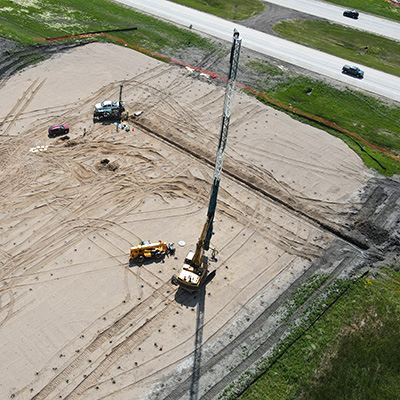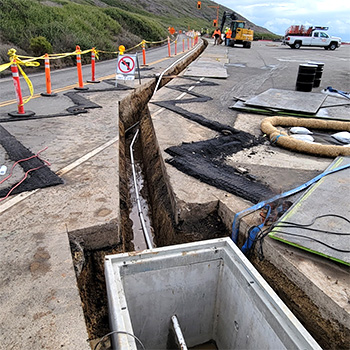Shape Arrays
Shape Arrays, also known as shape accel arrays, are advanced inclinometer-like instruments used to monitor lateral displacement, settlement or heave, and borehole deviation. Datasheet

Installing a vertical shape array to monitor
lateral movement at landslide remediation site

Installing a horizontal shape array to monitor settlement
About Shape Arrays
A shape array is an array of rigid segments connected by flexible joints. The joints are designed to resist twist but allow the segments to tilt in any direction.
Each segment is instrumented with three orthogonally mounted tilt sensors and a microprocessor. The microprocessor calculates the XYZ position of the segment relative to the next segment. The overall "shape" of the array is found by cumulating the XYZ positions of the connected segments.
Initial measurements serve as a baseline. Subsequent measurements, obtained at regular intervals, are compared to the baseline.
Changes from the baseline indicate that deformation has occurred and reveal the direction and magnitude of deformation.
Vertical Applications
- Monitoring lateral deformation or displacement of diaphram walls, sheet pile walls, and other earth retention systems.
- Monitoring subsurface movements in landslide areas, highway cuts, and embankments.
- Monitoring convergence in tunnels and other underground openings.
Horizontal Applications
- Monitoring settlement or heave of foundation soil during tunneling or jet grouting operations.
- Monitoring foundations of storage tanks.
- Monitoring settlement of roadways and railroad tracks.
- SAAX have been installed in horizontal boreholes above the path of a TBM, in trenches under roads, railroad tracks and embankments, and under storage tanks.
Deployment
Vertical shape arrays are typically installed into PVC pipe or inclinometer casing that has been installed in boreholes. Because of their extended tilt range, these shape arrays can be installed horizontally or in arcs to monitor tunnel deformation.
Horizontal shape arrays are typically installed into PVC pipe and embedded in shallow trenches or inserted into cased horizontal boreholes. They can also be fixed to railroad ties and other surface structures. Longer segments help reduce the cost for a given span.
Data acquisition: Both vertical and horizontal shape arrays are connected to wireless loggers. Reading time for a 100 foot array (50 segments) is approximately 10 seconds.
The wireless loggers then relay the measurements to the internet for processing and graphical display on GeoCloud websites.
Vertical shape arrays provide displacement profiles

At this slope stabilization project, GEO installed twelve shape arrays at depths from 40 to 90 feet. All of the installations were solar powered and provided with wireless connections to GeoCloud servers. A dedicated GeoCloud website presented profile plots, similar to the example plot at right, showing lateral displacements vs depth.


SAAV shape array installed at a CCR pond along with other instruments.

SAAV installation with a solar panel, logger, and wireless communications.

Rebar panel for diaphragm wall has reservation tube for SSAV (green line).
Horizontal shape arrays provide settlement profiles

Foundation soil for bridge approach was treated with wick drains. A 180 foot SAAX was embedded in the trench.

Profile plots show consolidation settlement along the 180 foot SAAX shape array. SAAX measurements, pore-pressure measurements, and settlement plate measurements confirmed that primary consolidation was complete.

SAAX monitored deflection of rail ties under load from crane. Blue box holds batteries and wireless logger.

SAAX installed below road surface to monitored for effects from cliffside erosion.

SAAX installed in horizontal borehole above path of TBM monitored heave from compensation grouting.
SAASCAN shape arrays provide borehole deviation data and plots

SAASCAN features heavy-duty joints that can withstand multiple insertions.

SAASCAN can be read on site with a portable computer.

Borehole deviation plot generated from SAASCAN data.
Shape Array Versions and Specifications

SAAV for Vertical Profiles
SAAV shape arrays are designed for vertical installation into existing inclinometer casing or void-forming pipe.
SAAV profile plots look similar to those made from traditional traversing probe inclinometers.

SAAX for Horizontal Profiles
SAAX shape arrays are designed for horizontal installation and provide measurements only for the vertical plane (settlement or heave).
Saax profile plots look similar to those made from horizontal traversing probe inclinometers.

SAASCAN - Borehole Deviation
SAASCAN shape arrays are designed for measuring borehole deviation for applications such as jet grouting. The SAAscan is constructed for repeated insertions into drill casing.
SAASCAN provides real-time readings as well as data for plots.
SAAV Specifications
Deployment: Vertical, horizontal, arc.
Segment length: 2 feet (610mm)
250 and 500 mm lengths also available.
Max array length: 600 ft
(longer lengths on special order).
Range: +/- 60 deg from vertical.
Resolution: 0.0003 inch per segment.
Precision: +/- 0.02" per 100 foot array.
Protective Pipe: 2 to 4 inch ID
also electrical conduit: 1 inch, schd 40.
Temperature rating: -4 to +140 F.
Pressure rating: 290 psi.
SAAX Specifications
Deployment: Horizontal.
Segment length: 1 m.
Max array length: 200m.
(longer lengths on special order).
Range: +/- 30 deg from horizontal.
Resolution: 0.012 mm/ m.
Precision: +/- 0.5 mm for 30m array.
Protective Pipe: 2" Sch 80.
Temperature rating: -4 to +140 F.
Pressure rating: 290 psi.
SAASCAN Specifications
Deployment: Vertical to near horizontal.
Segment length: 0.5m.
Max array length: 50m.
Range: +/- 60 deg from vertical.
Resolution: 0.012 mm/ m.
Precision: +/- 0.05 mm per 30m array.
Protective Pipe: none.
Temperature rating: -4 to +140 F.
Pressure rating: 600 feet water head.
ShapeArray™ is a registered trademark of Measurand Instruments Incorporated. SAAV, SAAX, and SAASCAN are Measurand products. Other names for the instruments are Shape Array and Shape Accel Array (SAA).
